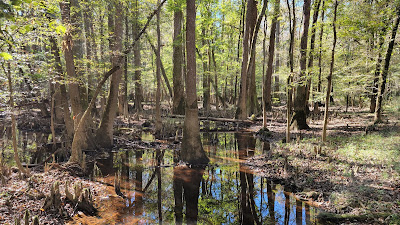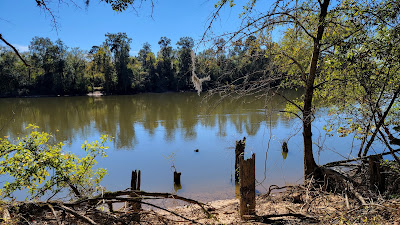We’ve been to lots of museums and historic sites over the last 10 years but there is always something to learn. At Hofwyl-Broadfield Plantation State Historic Site, we did the home tour, which was both interesting and a bit unsettling. The plantation used enslaved labor (350+ at one point) but the film about the rice plantation history only discussed the problems of the owners. The amount of work on this plantation was mind boggling. Over 7,000 acres were cleared of cypress trees and converted to a rice plantation with channels, dikes, and floodgates. Growing and harvesting rice involves a LOT of work in a hot, muggy, and buggy marsh. I think that work was more difficult that the financial problems of the plantation owners.

The tour guide said the slaves were “treated well” (really?). The owners left the plantation during the summer to avoid the heat and mosquitoes. They also added screens to the big house (one of the first homes with window and door screens) to prevent mosquitoes getting inside. The enslaved workers were left to work the rice fields in the heat but supposedly had no problems with malaria because they had sickle cell anemia. Online, I found that sickle cell does reduce malaria infection but by only 29% and also causes major health issues and early death. Plus, I am pretty sure not everyone had sickle cell anemia. The only building left of the slave homes at this site had half the building converted into bathrooms for us tourists.
The guide also was indignant that the US government asked Southern soldiers for an oath of allegiance after the Civil War. The guide again emphasized the financial problems of the plantation owners after the slaves were emancipated.
The tour guide highlighted the rich mahogany furniture in the home. She didn’t mention that enslaved workers in Caribbean and Central America were used to do the logging or that mahogany trees are widely separated in a forest so that the environmental damage is greater to log these trees than most trees. I was just surprised that in 2021 an historic site had such a limited point of view.
On a better note, the trees here were gorgeous. Some of the live oaks were over 800 years old.
I thought the vaseline glass was interesting. It uses uranium in the glass and glows under ultraviolet light.
We found the second place better. Fort King George State Historic Site shows a reconstructed fort (the southernmost British fort). There are several buildings within the fort area that you can see. It was built in the 1720s to protect the Carolinas from the Spanish and French but no battles were fought here.
There are stories of the soldiers who lived and died here. Apparently the older and infirm British soldiers were sent here and they were totally unprepared for the heat, humidity, and bugs. Other problems like river flooding, lack of food, alcoholism, and even (possibly intentionally) fires in the fort.
The museum had lots of artifacts that had been found here.
Along with some unsettling medical displays. Hey, every doctor needed a bleeding bowl to do some bloodletting.
The site also had information on saw mills and tidal power used back in the late 1700s. The water from a tide was stored in a pond and then used with a water wheel to power the saw mill. Sounds like a very sustainable energy source!

































